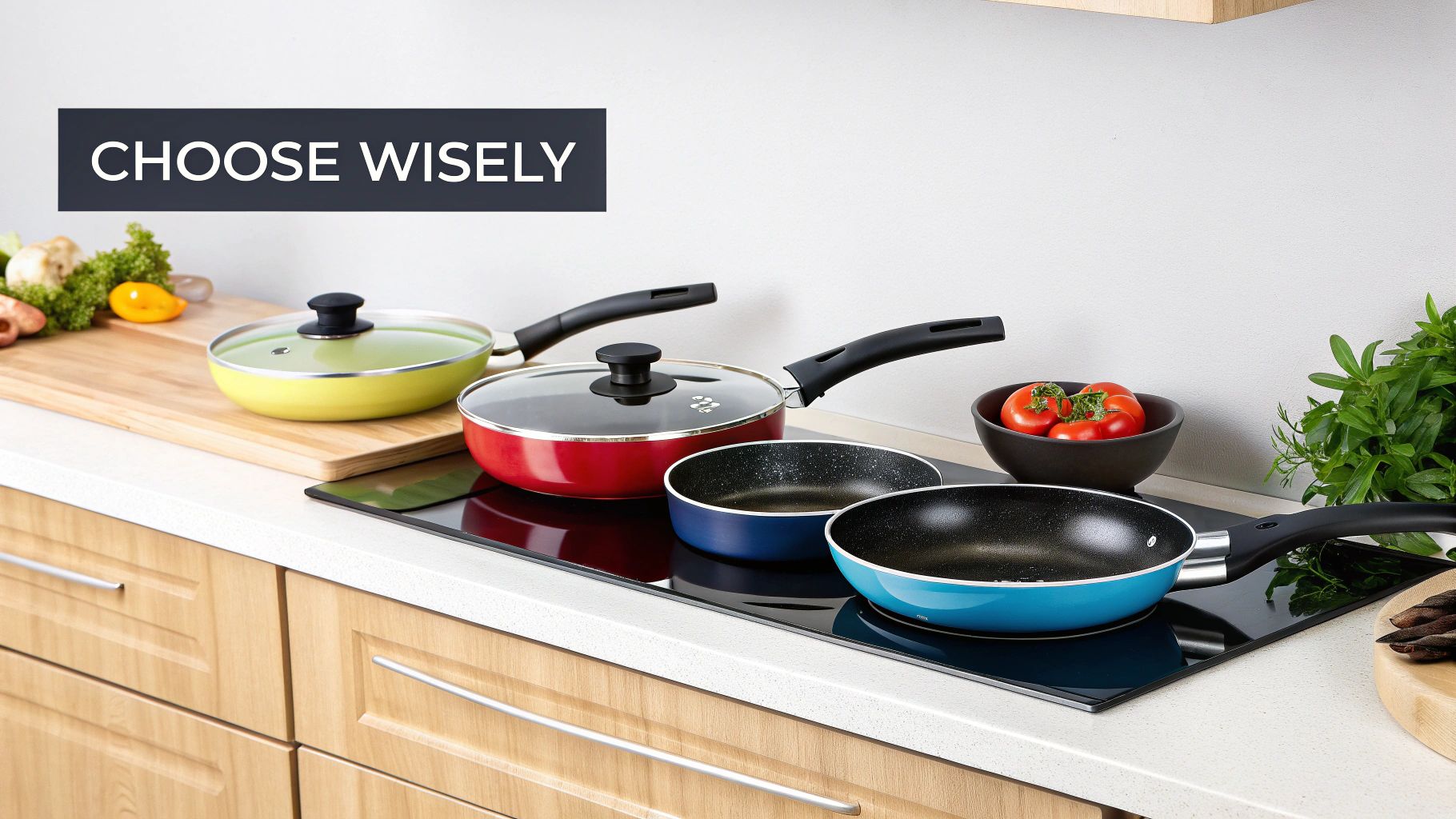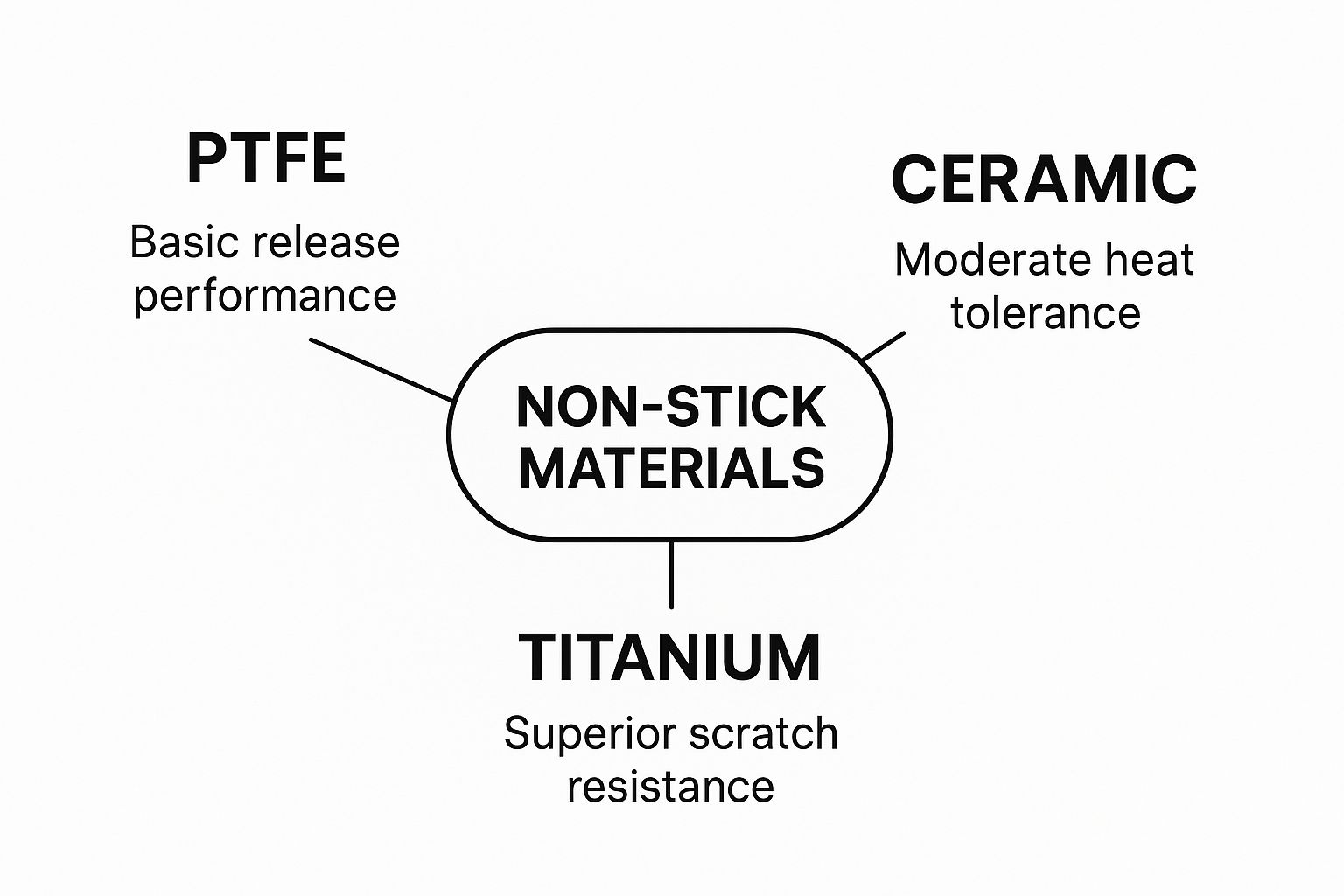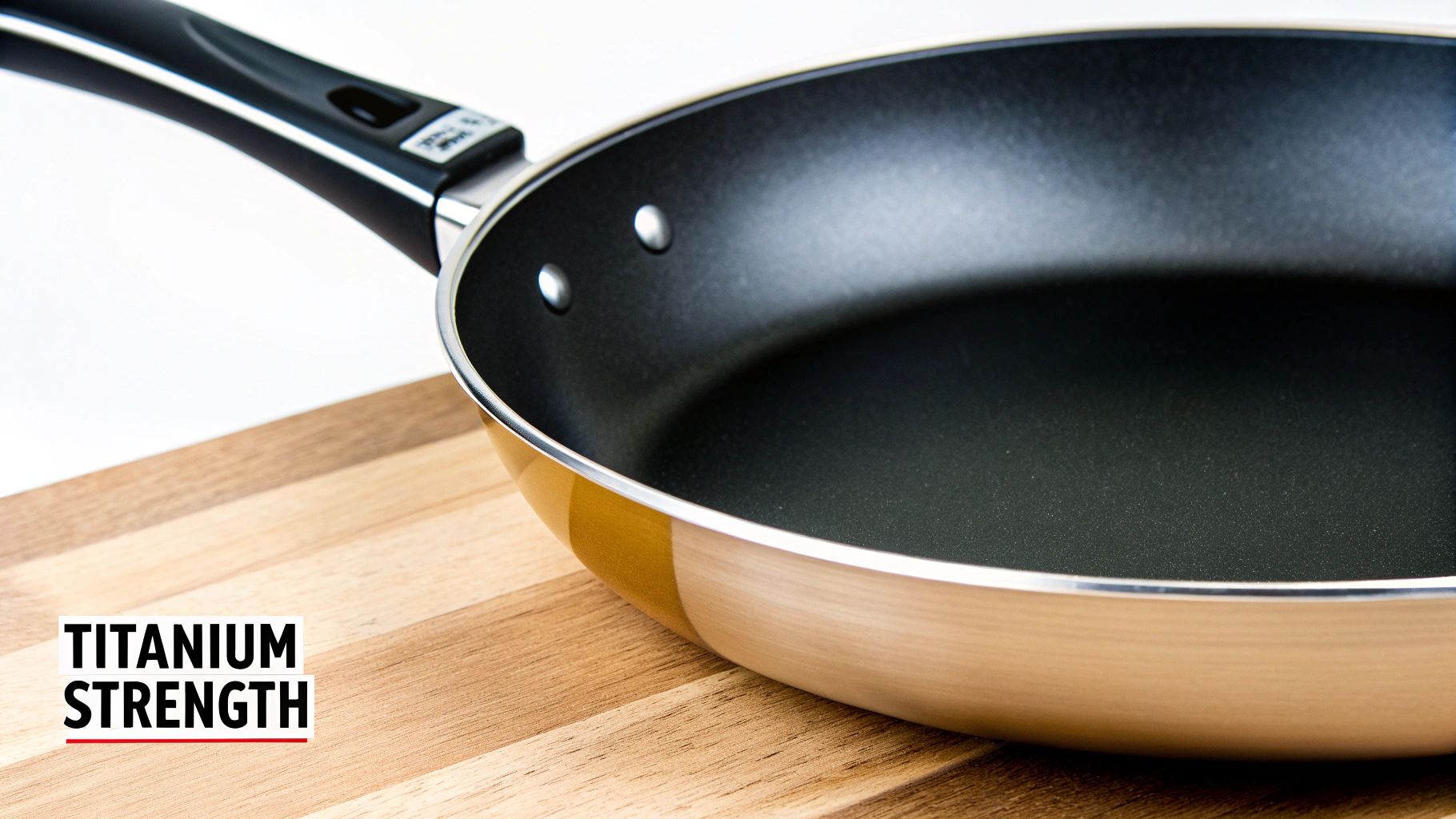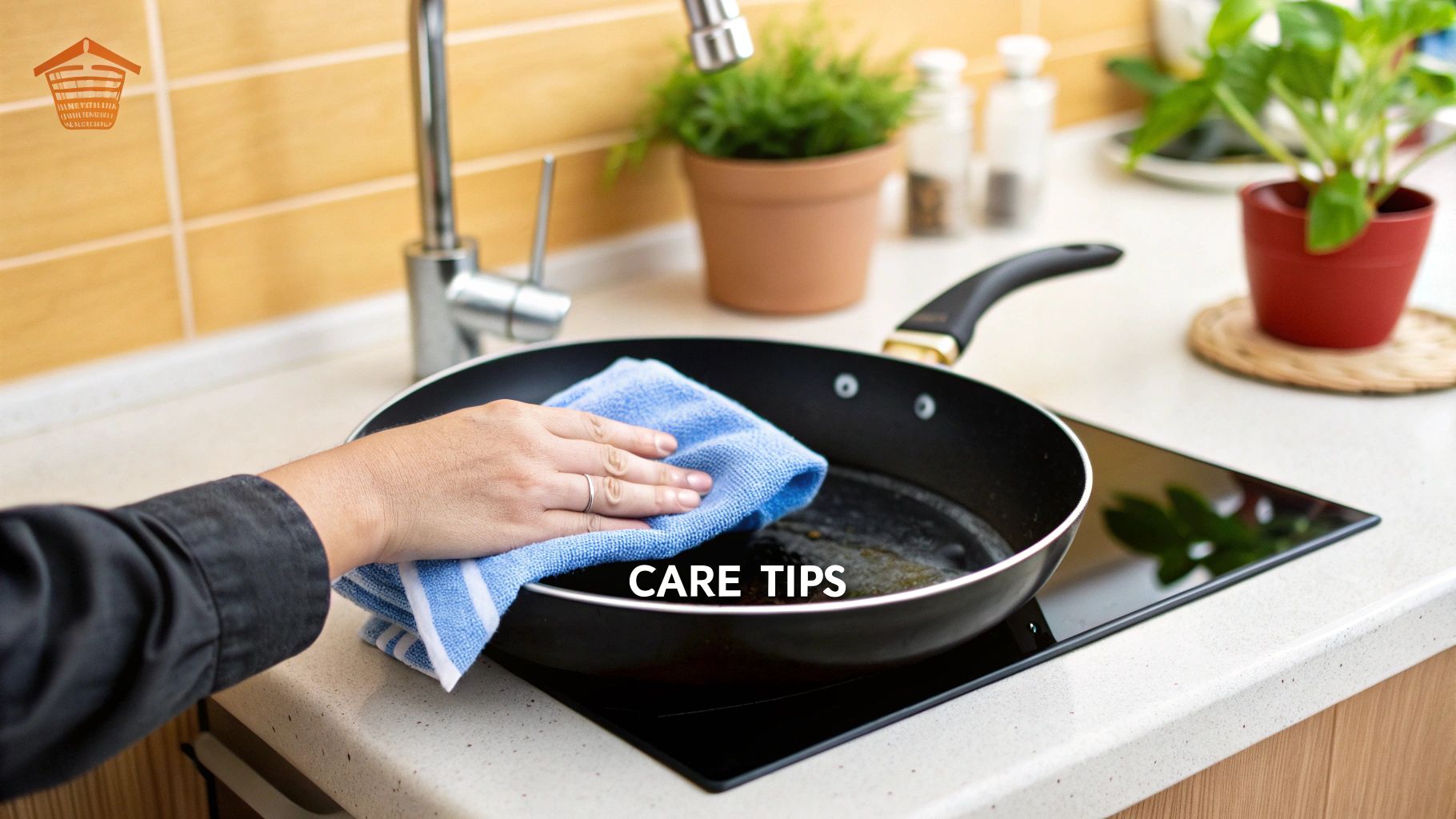If you’re on the hunt for the best non stick kitchenware, you've probably realised it's about finding that perfect sweet spot between durability, cooking performance, and health. There are plenty of options out there, but for home cooks who are serious about their gear, titanium-reinforced non-stick pans are consistently a cut above the rest, thanks to their incredible scratch resistance and longevity.
Your Guide to Choosing Non Stick Kitchenware

Walking into the kitchenware aisle can be a bit much. With a wall of different pans all promising the world, how do you actually find one that lives up to the hype?
The whole point of non-stick technology is to make life easier. It creates a surface that lets food glide right off, turning tricky jobs like flipping pancakes or searing fish into a breeze. It’s a game-changer for any modern kitchen.
But finding the best non stick kitchenware isn't just about how slick the surface is on day one. The real test is how it holds up over months, and even years, of regular use. That’s where the true quality shines through.
Key Factors in Your Decision
To make a smart investment, you need to look at the bigger picture. Here’s what really matters:
- Durability and Lifespan: How well does the coating stand up to metal utensils and the daily grind of cooking? A great pan is an investment, not something you have to replace every year.
- Health and Safety: Is it made without nasty chemicals like PFOA? Good-quality modern cookware puts non-toxic materials first, so you can cook with confidence.
- Cooking Performance: Does it heat up evenly, or are there annoying hot spots that burn your food? Consistent heat is the secret to getting perfectly cooked meals every single time. Digging into the details, like those in our guide to non-stick frying pans with lids, can really highlight how design impacts your cooking.
This shift towards quality isn't just a hunch; it’s a clear trend. The non-stick cookware market in Australia and New Zealand is on track to grow from USD 254.62 million to a massive USD 356.78 million by 2032. Why? Because busy people want gear that lets them cook with less oil and clean up in a flash.
Think of a non-stick coating like the sole of a running shoe. A cheap one wears out fast, leaving you with no support. But a high-performance sole gives you reliable grip and durability, run after run. Your kitchenware should deliver that same dependable performance, meal after meal.
Getting your head around these basics gives you a solid foundation for judging any pan. Now, you’ll be ready to dive into the more detailed comparisons we’re about to get into.
Comparing Different Non Stick Materials
Walk down any kitchenware aisle and you'll see a dozen different types of "non stick," but they're definitely not all created equal. The material used for the coating is the single biggest factor in how your pan will perform—it dictates everything from durability and heat tolerance to how long you can expect that effortless, egg-sliding-off-the-pan magic to last.
To make sense of it all, think of non-stick coatings like phone screen protectors. You've got your basic plastic film that does the job for a little while but scratches if you so much as look at it funny. Then there's tempered glass, a much tougher option that can still shatter with a bad drop. Finally, you have the premium sapphire glass, built to withstand the rigours of daily life. The same tiers of performance exist for your pots and pans.
Let’s get into the specifics of what you'll find out there.
Traditional PTFE Coatings
This is the one that started it all. Polytetrafluoroethylene (PTFE), better known by the brand name Teflon, is what most of us picture when we think of non-stick. It's famous for its incredible food release, which is why it became such a staple for home cooks.
But there's a catch: durability. PTFE coatings are notoriously soft. A quick scrape with a metal spatula or a scrub with the wrong kind of sponge can easily cause permanent damage. They also don't play well with high heat, which can cause the surface to degrade, destroying its non-stick power over time.
Modern Ceramic Coatings
Ceramic non-stick coatings are a popular alternative, often marketed as a "greener" choice. They're made from a silicon derived from sand, which means they are completely free of PFOA and PTFE.
Right out of the box, ceramic pans offer great non-stick performance and can handle a bit more heat than their traditional PTFE cousins. The trade-off, however, is that they tend to be brittle. This makes them susceptible to chipping if they get knocked around, and they can lose their non-stick properties surprisingly fast if tiny scratches or a build-up of cooking oil occurs.
The infographic below really helps visualise how these materials stack up against each other.

As you can see, while PTFE offers that basic food release and ceramic brings better heat tolerance to the table, titanium really shines with its superior scratch resistance. It’s in a different league.
Advanced Titanium Reinforced Surfaces
This is where kitchenware technology gets serious. Titanium-reinforced non-stick coatings are a huge leap forward. By embedding tiny particles of an incredibly hard metal—titanium—into the coating, manufacturers have created a surface that's exceptionally tough. It stands up to scratches, abrasion, and the general abuse of a busy kitchen.
Think of it like rebar in concrete. The titanium particles add incredible structural strength to the non-stick layers, preventing the peeling and flaking that plagues lower-quality pans.
This built-in resilience means titanium kitchenware lasts. A lot longer. It can handle higher temperatures without breaking a sweat and is far more forgiving if you accidentally use a metal utensil. You get the best of both worlds: the easy release of a classic non-stick pan combined with the kind of durability you'd expect from professional-grade equipment. It's an investment for people who genuinely love to cook.
It’s this demand for reliable, everyday performance that shapes the market. In fact, pans and woks are the biggest sellers in the non-stick world, accounting for about 52.68% of all revenue. This just goes to show how much we rely on these workhorse tools for daily stir-frying and sautéing, where a tough, easy-to-clean surface is non-negotiable. Discover more insights about the cookware market on Fortune Business Insights.
The Truth About Non-Stick Pan Safety
The conversation around non-stick pan safety can be a minefield of conflicting advice and old news. So, let’s clear the air. For years, the big villain was a chemical called Perfluorooctanoic acid (PFOA), which was once part of the manufacturing process for some PTFE coatings (think Teflon).
But here’s the thing: the kitchenware industry has moved on. Since 2013, PFOA has been phased out by all reputable manufacturers. Any decent non-stick pan you buy today is PFOA-free, which means that particular worry is now a thing of the past for modern cooks. The real conversation we should be having is about how we use our pans today.
Understanding Heat and Material Stability
When it comes to non-stick safety, heat is the most important factor. If any non-stick coating gets too hot—past its smoke point—it can start to break down and release fumes. This isn’t something you’ll encounter with everyday cooking, but it’s something to be aware of if a pan is left to overheat.
For example, a traditional PTFE coating can begin to degrade if it gets hotter than 260°C. You’d really only hit that kind of temperature if you left an empty pan cranking on a high burner for several minutes.
A great rule of thumb is to never preheat a non-stick pan empty. Always have a little oil, butter, or your ingredients in the pan when you turn on the stove. This simple step helps manage the heat and keeps the surface temperature safely in the right zone.
Of course, not all non-stick surfaces are created equal. Different materials have different thresholds for heat, and that’s a big deal when you're looking for the best non-stick kitchenware that gives you total peace of mind. For a deeper dive into how materials stack up, our guide on what makes for healthy cooking pans is a great resource.
A Practical Approach to Safe Cooking
Choosing a pan with a more stable, robust coating simply gives you a bigger safety margin against accidental overheating. Titanium-reinforced surfaces, for instance, are well known for their incredible heat stability, staying safe and sound at temperatures where other conventional coatings might struggle. That built-in durability is a huge plus.
Here’s how you can cook confidently with any non-stick pan:
- Avoid Extreme Heat: Stick to low to medium-high heat. You can get a perfect sear without red-lining your burner.
- Keep the Air Moving: It's always a good idea to flick on your rangehood fan when cooking, especially if you're searing or frying.
- Choose Durable Materials: A tougher coating like titanium is less likely to scratch or degrade, which means the non-stick surface stays intact and safe for much longer.
By keeping these simple tips in mind, you can enjoy all the convenience of non-stick cooking without a shred of worry. Modern, well-made pans are designed to be both safe and effective when used correctly.
Why Titanium Is a Superior Choice for Kitchenware

After weighing up all the different non-stick materials out there, one option consistently comes out on top for serious home cooks. Titanium-reinforced kitchenware isn't just another product on the shelf; it's a genuine leap forward in both performance and longevity. It directly addresses the common headaches that come with lower-quality pans, making it a truly worthwhile investment for any kitchen.
Think of your non-stick pan as the unsung hero of countless meals. A flimsy one will inevitably fail, but one built on a solid base provides stability and reliability, meal after meal. That’s precisely what titanium brings to the table—it reinforces the non-stick surface, creating a workhorse ready for the rigours of a busy kitchen.
Unmatched Durability and Scratch Resistance
The first thing you’ll notice about titanium is its sheer toughness. By infusing the non-stick coating with titanium particles, manufacturers have created a surface that’s exceptionally resistant to everyday scratches and scuffs. This has real, practical benefits that change how you approach cooking.
While it's still best practice to use silicone or wooden utensils, a titanium pan is far more forgiving if you accidentally scrape it with a metal spoon. This built-in durability means the non-stick performance doesn't just vanish after a few months. It's the secret to finding the best non stick kitchenware that actually lasts.
This resilience translates directly to a much longer lifespan. Instead of tossing out a basic non-stick pan every year or two, a high-quality titanium pan can deliver flawless performance for years on end, making it a smarter choice for both your wallet and the environment.
This long-term value is a huge reason why cooks who value quality are turning to titanium. It’s about buying once and buying well, instead of getting stuck in a cycle of disposable kitchen gear. To get the full picture, you can explore more about the pros and cons of using titanium cookware and see if it’s the right fit for you.
Superior Heat Distribution and Performance
Beyond its brawn, titanium excels at what matters most: helping you cook incredible food. Pans reinforced with this metal are usually built with a multi-layered base, often with an aluminium core, which guarantees heat spreads quickly and evenly right across the cooking surface.
This puts an end to those infuriating hot spots that burn your food in one area while leaving another part raw. So, what does this mean for your cooking?
- A Perfect Sear: You'll get that beautiful, even crust on a steak or piece of fish without any burnt edges.
- Consistent Results: Delicate foods like omelettes and pancakes cook uniformly from the middle to the very edge.
- Total Control: The pan reacts instantly when you adjust the heat, giving you precise command over the cooking process.
On top of all that, titanium is a non-reactive material. This means it won't give your food a metallic taste, even when you’re cooking with acidic ingredients like tomatoes, wine, or lemon juice. The flavour of your ingredients stays pure and clean, letting your cooking truly shine. The result is simply better-tasting food, every single time.
How to Care for Your Non Stick Kitchenware

Choosing the right non-stick kitchenware is a great start, but making that investment last is where the real value comes in. By building a few simple habits, you can protect your pan’s surface and keep it performing like new for years. Every meal will be just as effortless as the first.
Think of your non-stick pan like a quality chef's knife – it's a precision tool that works best when you treat it with a bit of respect. A little care goes a long way in preserving that slick, easy-release coating that makes cooking and cleaning up such a breeze.
It's clear people are looking for quality that lasts. The Australian cookware market was valued at about USD 664.44 million and is tipped to reach USD 1.37 billion by 2033. This growth is all about our passion for home cooking and the demand for high-performance gear that stands the test of time. You can learn more about cookware market trends on Grand View Research.
The Do's of Daily Pan Care
To get the most out of your non-stick surface, try weaving these simple practices into your daily routine.
- Wash Gently by Hand: The best way to clean your pan is with warm, soapy water and a soft sponge or cloth. Dishwasher detergents are often too harsh and can break down the coating over time.
- Use the Right Tools: Always reach for wooden, silicone, or nylon utensils. These materials are kind to the non-stick surface and prevent the tiny scratches that eventually lead to food sticking.
- Store with Care: Try not to stack pans directly on top of each other. If you’re short on space and have to, just slide a soft cloth, a paper towel, or a proper pan protector between each one to stop them from getting scuffed.
Common Mistakes to Avoid
Knowing what not to do is just as important. Most pans meet an early end because of a few common, and easily avoidable, mistakes.
The number one rule is to avoid extreme and sudden temperature changes. Never plunge a sizzling hot pan into cold water. This thermal shock can warp the pan and ruin the non-stick coating. Just let it cool down on the stovetop first.
Another crucial point is managing your heat. Always cook on low to medium-high heat. You rarely need to crank the burner to maximum, as intense heat can degrade the coating and shorten your pan's life. And never heat an empty non-stick pan—a little oil or food helps absorb and distribute the heat, keeping the surface safe.
Common Questions About Non Stick Cookware
Even after wading through all the details, you probably still have a few questions buzzing around. That’s completely normal. Picking the right non stick kitchenware is a big deal for your kitchen, so you want to get it right.
This section is all about tackling those common queries head-on. We'll clear up any confusion around safety, how long your pans should last, and whether that higher price tag is actually worth it. By the end, you'll have the confidence to choose cookware that genuinely fits your life.
What Is the Safest Type of Non Stick Kitchenware?
Let’s get this one out of the way first. Modern non-stick cookware is safe, as long as you stick to reputable brands and use the pans as intended. The most important thing to look for is a PFOA-free guarantee, which takes care of the main health concern linked to older non-stick pans.
If you want an extra layer of peace of mind, titanium-reinforced pans are a brilliant choice. Their coatings are incredibly stable, even at high heat, and they’re tough as nails when it comes to scratches. This durability means there's very little risk of the surface breaking down, which is why health-conscious cooks often gravitate towards titanium.
The safest kitchenware isn’t just about the material. It's about how it’s made. A solid, well-built pan that resists damage is naturally safer because the cooking surface stays intact, year after year.
How Often Should I Replace My Non Stick Pan?
Honestly, this all comes down to quality. A cheap, basic pan you grab off the shelf might only last one to two years before food starts sticking and the surface looks worse for wear.
This is where investing a bit more pays off. A high-quality titanium pan is built to last. When you care for it properly (using the tips we’ve already covered), a premium pan can serve you well for many, many years. It’s a much smarter long-term investment and a more sustainable option than constantly throwing away and replacing cheaper pans.
Can I Use Metal Utensils on My Non Stick Pans?
For almost every non-stick pan out there, the answer is a hard no. Metal spatulas and spoons will easily scratch and ruin a standard non-stick surface, cutting its life short.
But this is precisely where premium titanium coatings stand out from the crowd. Their incredible durability and scratch resistance mean they can handle the occasional and careful use of metal utensils. It gives you a lot more flexibility when you're in the middle of cooking and just need to grab what's closest, setting these pans apart from their more delicate counterparts.
Is More Expensive Non Stick Kitchenware Worth the Investment?
In a word: absolutely. It might feel like a bigger spend upfront, but premium non-stick kitchenware pays you back in three major ways: performance, safety, and longevity.
Here's what that extra investment really gets you:
- Thicker Construction: Pricier pans usually have a multi-layered base. This means they heat up fast and, more importantly, evenly, so you can say goodbye to annoying hot spots.
- Durable Coatings: They use advanced, reinforced surfaces like titanium that are built to resist damage and last for years, not months.
- Better Design: You can feel the difference. Better balance, comfortable handles, and just a more enjoyable cooking experience all around.
When it comes down to it, you'll get more enjoyment out of your time in the kitchen and won't be stuck replacing your pans every couple of years. It’s a move that saves you money in the long run.
Ready to experience the lasting difference of premium titanium? Everti creates lifetime essentials for the modern kitchen, designed for superior performance, safety, and durability. Discover the full collection and elevate your cooking at https://everti.com.au.

